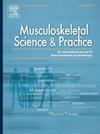物理治疗学生对颈椎框架如何影响其临床推理的看法:加拿大一所大学的定性单一案例研究
IF 2.2
3区 医学
Q1 REHABILITATION
引用次数: 0
摘要
颈部疼痛和头痛是非常普遍的,经常提出一个挑战,物理治疗师在考虑鉴别诊断。作为指导,国际手工和肌肉骨骼物理治疗师联合会(IFOMPT)创建了国际IFOMPT颈椎框架。其目的是通过各种功能目标和设计原则来提高临床推理能力。尽管颈椎框架支持物理治疗学生的临床推理,但如何实现这一目标尚未探索。探讨物理治疗学生对颈椎框架功能目标如何影响其临床推理的认知。探讨理疗学生对颈椎框架设计原则如何影响其临床推理的看法。设计定性的、建构主义的、探索性的、单案例研究。方法采用半结构式访谈法,对某大学物理治疗专业的学生进行访谈。根据子宫颈框架的功能目标和设计原则,使用直接定性内容分析来解释数据。从18名参与者中,发现了所有功能目标的有意义的数据,在评估和提高风险理解期间为临床推理提供信息时具有特殊价值。学生在治疗过程中告知临床推理和促进以患者为中心的实践方面表现出混合的感知价值。物理治疗专业学生对颈椎框架的认知与其大部分设计原则一致,尤其是其信息丰富、简单、非规定性。学生还认为颈椎框架太长,这可能影响了参与度。结论本案例研究中的物理治疗学生认为颈椎框架通过实现其功能目标和成功遵守其设计原则来影响他们的临床推理。本文章由计算机程序翻译,如有差异,请以英文原文为准。
Physiotherapy students' perceptions of how the Cervical Framework influences their clinical reasoning: A qualitative single case study of a Canadian university
Background
Neck pain and headaches are highly prevalent, often presenting a challenge for physiotherapists when considering differential diagnoses. For guidance, the International Federation of Manual and Musculoskeletal Physical Therapists (IFOMPT) created the International IFOMPT Cervical Framework. Its purpose is to improve clinical reasoning through various functional objectives and design principles. Although the Cervical Framework supports clinical reasoning among physiotherapy students, how this is achieved is unexplored.
Objectives
1. To explore physiotherapy students’ perceptions of how the Cervical Framework’s functional objectives influence their clinical reasoning.
2. To explore physiotherapy students’ perceptions of how the Cervical Framework’s design principles influence their clinical reasoning.
Design
Qualitative, constructivist, exploratory, single-case study.
Method
Semi-structured interviews of physiotherapy students enrolled in one of three educational programs at one university were conducted. Directed qualitative content analysis informed by the Cervical Frameworks’ functional objectives and design principles was used to interpret data.
Findings
From eighteen participants, meaningful data were found for all functional objectives, with particular value when informing clinical reasoning during assessment and improving understanding of risk. Students showed mixed perceived value in informing clinical reasoning during treatment and facilitating patient-centred practice. Physiotherapy students’ perceptions of the Cervical Framework align with most of its design principles, especially its informative, simple, and non-prescriptive nature. Students also perceived the Cervical Framework as long and this may have affected engagement.
Conclusion
Physiotherapy students in this case study perceive the Cervical Framework to influence their clinical reasoning by achieving its functional objectives and by successfully adhering to its design principles.
求助全文
通过发布文献求助,成功后即可免费获取论文全文。
去求助
来源期刊

Musculoskeletal Science and Practice
Health Professions-Physical Therapy, Sports Therapy and Rehabilitation
CiteScore
4.10
自引率
8.70%
发文量
152
审稿时长
48 days
期刊介绍:
Musculoskeletal Science & Practice, international journal of musculoskeletal physiotherapy, is a peer-reviewed international journal (previously Manual Therapy), publishing high quality original research, review and Masterclass articles that contribute to improving the clinical understanding of appropriate care processes for musculoskeletal disorders. The journal publishes articles that influence or add to the body of evidence on diagnostic and therapeutic processes, patient centered care, guidelines for musculoskeletal therapeutics and theoretical models that support developments in assessment, diagnosis, clinical reasoning and interventions.
 求助内容:
求助内容: 应助结果提醒方式:
应助结果提醒方式:


